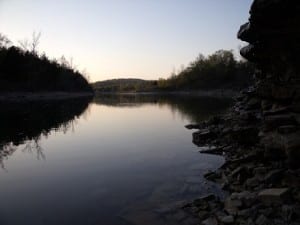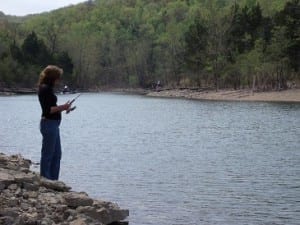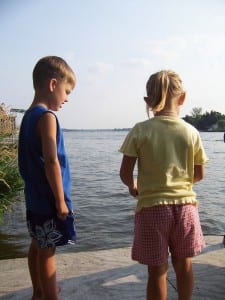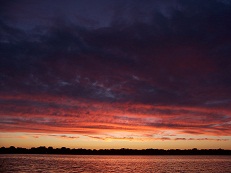?
?Here’s a pro’s view of the newest artificial fish habitat from Fishiding.com




Pond Boss subscriber Shane Howell of Dallas stepped on rocks near one of five shoreline feeders surrounding his spanking-new 30-acre Oklahoma lake. He pushed the timer button, then stood back to watch the action as thousands of tiny protein-laced nuggets pelted the water’s surface. 
Hundreds of young bluegill and fathead minnows welcomed the offering, and quickly dispensed with the free meal, in a frenzy fit for starving piranha.
“We designed and stocked this lake to become a trophy bass lake,” Howell said with a smile, “and part of our management plan is to feed the baitfish.”
Feed the baitfish? What gives? Why put protein pellets in the water that the top-end gamefish may or may not eat?
Those are questions many fish pond owners ask themselves. Should you feed your pond fish? Nationwide, biologists disagree on the issue of feeding pond fish.
Proponents point out that high-protein pellets supplement the natural food supply in a fish pond and directly boost growth-rates among certain species, while indirectly improving the rates on some others. Rainbow trout, for instance, can be fed like so many barnyard chickens.
Then again, you might hear some negatives, such as: It’s a commitment. The cost is prohibitive. Feeding causes fish to congregate, altering their behavior. It’s like welfare. Pellets aren’t “natural” in a pond. Water quality is changed, forever.
So’s which side is right? Here’s how to decide the issue for yourself.
If you want to expedite growth-rates of bluegill, catfish and trout, or if you want to increase standing crops of fish in your pond, the answer is simple. Feed the fish.
For every two pounds of protein-rich, pellets (I recommend the floating variety) a group of fish consumes, those fish collectively gain a pound. The fish in your pond now weigh one more pound than before. Two pounds of feed, a pound of fish, and so on.
Let’s look a little deeper into the numbers. The best fish foods cost about 30 cents a pound. So, 60 cents of feed grows a pound of fish.
Stocked any fathead minnows lately? Priced at $10 a pound, fathead minnows can not compete with commercial pellets when it comes to feeding your pond fish.
Trying to grow huge largemouth bass? So many Pond Boss readers are.
Ol’ Bucketmouth won’t dare eat a prepared, pelleted diet. Heck, sitting atop the food chain, with a mouth big enough to swallow a cantaloupe, bass can eat anything in the pond, especially living critters. Bass snub tiny little pellets. Largemouth have bigger fish to fry, so to speak.
But what does a largemouth love to eat? Bluegill. And Mr. Bluegill loves to eat pelleted fish food.
Aha. Feed the fish that feed the bass. By so doing, you have created your own miniature food chain.
A well-managed pond, covering half a surface acre up to three acres, can grow and maintain 200-to-300 pounds of channel cat or trout along with 200-to-300 pounds of forage fish, per surface acre. That’s with an abundant supply of bluegill and other forage species. But, if you were to add high-protein fish food, the same pond can easily double that production.
Arguments arise. Is feeding a commitment? You tell me.
Much of the U.S. has at least 200 days of growing season, slightly less in the Upper Midwest and northern New England, fewer still in Canada. For the sake of creating a model feeding program for a mythical pond, let’s just say you intend to feed only three or four days, maybe five days some weeks. 
Your fish consume all of what you feed, say four pounds a day per surface acre of water. Over the course of 150 days, you feed 600 pounds of feed. Those 600 pounds of feed yield 300 pounds of fish, doubling your ponds natural production capabilities.
Do the math: Six hundred pounds of feed, at 30 cents a pound … $180. Less than $200 to put 300 pounds of weight on your fish. Cheap. I consider that a bargain.
Can you feed more? Sure, but be careful.
Two pounds of feed yields a pound of fish, but there is a balancing act to consider. For every pound you feed to the fish, there’s a pound of nutrients, some converted to energy, some processed by the fish and expelled into the water as waste. When waste dissolves in your pond, the water must process it.
Too much feed can result in too many pounds of fish, too many pounds of waste, and ultimately, problems with your water quality, if your pond water can not work with Mother Nature to clean up the extra mess. In extreme cases, I have seen overfed ponds end up with massive die-offs related to poor water quality and low levels of dissolved oxygen.
Feeding catfish? Grow Mr. Whiskers to two pounds, then catch and eat the little darling. Want bigger catfish? Stock lower numbers in the beginning. Want to name them? Stock fewer yet.
In short, do not overfeed, or plan on removing a few fish as you go along. Otherwise, your fish and your water quality will suffer.
Here’s one of my Rules of (Wet) Thumb: Never feed more than 10-to-20 pounds of floating fish food, per surface acre, per day.
Theory can get a little complicated, since young, fuel-burning fish, converting at a rate of 2-to-1, will eat 3 percent of their body weight per day during the growing season. So, keep your feeding program simple. 
To keep it simple, I recommend that in most sportfishing ponds that you feed no more than twice a day, for brief durations, once in the morning, once in the late afternoon. Feed only what the fish will clean up 10-to20 minutes. Otherwise, you’re wasting your money to watch the wind and waves carry your pellets to the other side of the pond.
Either way, keep your feeding program simple and consistent. Feed from the same place, same time, each day. As your fish grow, you may discover that where you once were feeding for production, now you are feeding to maintain. That’s when you reach decision time.
Do you feed the same amount of feed, to the same number of fish that stay the same size? Or do you reduce numbers to increase individual size?
Some biologists contend that feeding fish is akin to welfare. It creates an artificial environment. Point well taken.
Granted, when you offer pellets to a fish, it tends to leave the real world of fish-eat-fish. But it’s a balancing act. The fish you feed are not necessarily taken out of competition, but they compete less with other fish for natural prey in your pond.
In that regard, feeding pellets makes “more” natural food, to be distributed among all fish, not just a few. This increases a pond’s ability to support fish — the very point of pond management. 
Critics say a feeding station tends to congregate fish, to pull them away from their natural underwater home. Absolutely. When the dinner bell rings, fish come from as far as 100 feet away.
Bluegill and minnows surface to attack the pellets, then disappear just as quickly as they came. Hybrid stripers can put on quite a show of force when they gulp down pellets. Bass take note, too. A big bass will not be attracted to the pellets, but to the creatures partaking of the free offerings.
After all, bass won’t turn down an easy meal either. Bluegill eat fish food; bass eat bluegill eating fish food. In nature, there’s always a payback.
Too many fish can jeopardize water quality, so feed less or reduce the number (or size) of the fish. One option is adding an aerator. The tiny air bubbles bursting at the surface help Mother Nature to combine oxygen and sunlight in helping to flush or “burn” the waste products.
Rule of (Wet) Thumb: Buy good fish food. Read the bag tag, make sure the feed contains at least 28-to-32 percent digestable protein. Read the ingredients, looking for the words “fish meal.” If you don’t see those words, don’t buy the food.
For best results, use only feed intended for fish. Feed dog food to dogs, monkey food to monkeys. Your fish deserve the real meal deal.
When it comes to feeding, pond owner Shane Howell has it figured out.
“Since our goal is to grow trophy bass, and this is the first year our lake has been stocked,” he said, “we decided to grow as much baitfish as possible, to grow the biggest bass possible.”
Howell knows that it takes at least 10 pounds of baitfish for his bass to gain a pound. In his fishing hole in south-central Oklahoma, five feeders pitching out 10 pounds of feed each day will set the buffet table for his bass to grow as fast, and as large, as they can.
Howell has done the math … 10,000 pounds of feed over 200 days will produce an extra 5,000 pounds of baitfish for the 1,500 Florida bass fingerlings he recently stocked. That’s an extra 170 pounds of baitfish per acre, (above what the lake produces without feeding) that will make his bass grow to large sizes much more quickly than a “normal” lake of similar size.
The irony of Shane’s program is that when he buys $3,000 worth of feed, the largemouth will be growing rapidly, without eating so much as one pellet.
POND BOSS Magazine is the world’s leading resource for fish, pond and fisheries management information including discussions on muddy water, raising trophy fish, fish feeding, building a pond, algae control and more. Check us out at www.pondboss.com or contact Bob Lusk, the Pond Boss himself, at 903-564-5372. His books, Basic Pond Management, Raising Trophy Bass and Perfect Pond, Want One, may be purchased by calling 800-687-6075 or ordering online at www.pondboss.com
Ralph Manns is a trained fisheries biologist and contributing writer for several fishing magazines. He resides in Rockwall, Texas.
When largemouth bass feed actively, they move. Underwater observers, scientific experimenters, and electronic trackers all report the same things: black bass hold inside or near to cover when they are inactive and resting. When they are actively feeding, they move outside thick cover and usually travel along edges.
The slim, muscular, and streamlined shape of bass is best suited to make short dashes after forage fish. It is less well designed to ambush forage fish by lying hidden and camouflaged inside cover. Predator fish that routinely feed by ambush usually have several characteristics in common. They are bulky, camouflaged, sit on the bottom, and move only inches when they strike. Moreover, ambush feeders normally have big mouths and heads and relatively small bodies and few muscles because they move little and often must wait many days between feedings. Sculpin, rockfish, halibut, and sole are typical ambush predators.
Experiments in which bass were given chances to feed inside and outside cover show bass forced to live inside thick cover are unable to chase forage fish and are forced to use ambush tactics. These bass catch few forage fish, grow slowly, and may even starve if forage fish aren’t abundant. Although they sometimes ambush forage fish, ambush is an inefficient tactic for bass.
Bass that can leave cover to cruise individually or in small schools along edges of thick cover do so. They startle individual forage fish and scatter forage fish schools. Forage fish that dart the wrong way or dash too near another bass were eaten. Big bass expert Doug Hannon calls this tactic “flushing.” The tactic is suited to bass’ ability to cruise at slow speed and then to accelerate rapidly to strike vulnerable forage fish a few feet away.
When forage fish aren’t overabundant, cruising bass encounter and have chances to catch many more forage fish than ambushing bass. Studies show bass feeding along the edges of thick cover catch enough food to grow and remain healthy.
Scuba divers, me included, have watched bass that were immobile inside cover and apparently asleep. These fish didn’t feed, even though edible-size forage fish were within inches of their mouths. These inactive bass also refused fishing lures presented within inches of their noses and were almost impossible to catch-unless something aroused them from their torpor before the lure passed by. Electronic trackers frequently report that bass that hold for long periods in the same place aren’t usually catchable.
In contrast, bass that held near the edges of cover and moved back and forth were occasionally tempted by fishing lures that were placed nearby. They were also more easily aroused to active status by repeated casting. These bass are usually neutral or semi-active. Neutral bass tended to hold near other bass, but don’t synchronize their movements or hold close together. Scientists call such groups “aggregations” rather than schools. Forage fish often hover nearby, but stay at least 3 feet away and remain constantly wary. Neutral bass will strike forage fish that blunder too close and often drift around rather than holding in one place only. Electronic trackers often report these local wanderings, but anglers find only precisely placed casts interest such fish.
When bass want to feed actively they form schools with bass of similar sizes and swim off together. They cruise fairly steadily along edges of cover (into open water if there are many bass and shad are abundant) to flush forage fish. These are active, catchable fish if anglers can locate them, predict their direction of movement, and put a lure in front of them. Nearby forage fishfish know when bass were preparing to feed and immediately move well out of range. The bass move away looking for forage fish that haven’t seen them coming.
The idea that bass feed by ambushing forage fish apparently resulted from some 0 observations and assumptions. Bass are inactive or neutral most of the time. While inactive, they frequently rest inside thick cover. It they aren’t digesting food, too sleepy, and totally immobile, lures flipped right on their noses may be taken. They also may wake up it aroused by repeated casts. Thus many bass are caught in cover where ambush is the most likely tactic. Moreover, moving bass still may stop periodically at places where cover or structure stops, starts, bends, or changes. Bass taken at these locations may seem to ambush lures or forage fish, even though the bass aren’t actually hiding there.
Bass usually don’t move only one way. Lunker bass monitored by Texas bass-tracker, John Hope, moved almost constantly when active, but they patrolled to-and-fro along the edges of cover or break-lines. Anglers who “hole-sit” on edges, bends, and points of weed beds or other cover during feeding periods may encounter several schools of passing bass or contact the same school several times as it passes back and forth. This can create an illusion that the feeding bass aren’t moving. Active bass also move along cover edges anglers can’t see. Fairly open pathways often exist under thick weeds and seemingly impenetrable brush. Fish that are apparently caught “inside” such cover may be moving along relatively open edges. It’s hard for anglers to tell the difference between a bass that was caught while holding inside or under a bush to “ambush” forage fish and another that was moving back and forth at the same depth under a cluster of bushes.
Truly inactive bass tend to sleep alone. When bass anglers take several fish during consecutive passes by the same bush, they likely have found a spot that fish are moving through rather than resting fish. Inactive bass seldom school, don’t strike readily, and don’t move about rapidly enough to quickly replace bass that were caught moments before.
The belief that bass “ambush” their prey apparently worked its way into bass fishing lore because many outdoor writers prefer to use aggressive, action-packed words. The image of a bass hiding behind a rock to “ambush” unsuspecting prey makes bass seem vicious, like a western movie “back-shooter.” and therefore a more worthy opponent. “Chasing” or “flushing” tactics just don’t make bass seem as tough and exciting. But “ambush” is the wrong word to describe how bass usually feed. Bass ambush if opportunity presents itself, but this is not their preferred feeding tactic.
To catch more bass, anglers must know how bass really behave. Actively feeding bass usually move in small groups. They usually don’t hide inside cover thick enough to block their vision and/or hinder attacks. Cover is cover for forage fish. Forage fish hide in it to escape bass. Bass use cover for the same reason. They move into it to rest undisturbed by larger threats like yellow catfish and anglers, rather than to feed. Bass are most often caught along the edges of cover because forage fish gather there and are more easily flushed there.
To feed effectively and often, bass move out of thick cover to seek, startle, or flush forage fish along the cover edges in ponds and reservoirs. Most pond owners will see and confirm this fact for themselves if they sit at pondside, as I do almost every day, and watch bass using Polaroid glasses.
POND BOSS Magazine is the world’s leading resource for fish, pond and fisheries management information including discussions on muddy water, raising trophy fish, fish feeding, building a pond, algae control and more. Check us out at www.pondboss.com or contact Bob Lusk, the Pond Boss himself, at 903-564-5372. His books, Basic Pond Management, Raising Trophy Bass and Perfect Pond, Want One, may be purchased by calling 800-687-6075 or ordering online at www.pondboss.com
 If you own or manage private waters anywhere in the world – or want to – Pond Boss is the leading authority. Pond Boss magazine and pondboss.com provide valuable, up-to-date information on the topics, products and services you need to be a better steward of your land and water. Learn and share from the nation’s leading pond management experts and our family of friends. We stand ready, willing and able to assist.
If you own or manage private waters anywhere in the world – or want to – Pond Boss is the leading authority. Pond Boss magazine and pondboss.com provide valuable, up-to-date information on the topics, products and services you need to be a better steward of your land and water. Learn and share from the nation’s leading pond management experts and our family of friends. We stand ready, willing and able to assist.
Published six times a year, Pond Boss brings you information you can actually use to manage your private waters. From planning your dream pond to raising trophy bass, each issue of Pond Boss delivers:
Our Readers Say It Best!
“I love Pond Boss magazine! If you have a pond, you need this magazine.”
– Ray Scott, founder of B.A.S.S. and father of bass fishing, Alabama
“I’ve subscribed to Pond Boss since its inception in 1992. I read every issue and always come away with at least a nugget or two of information I can actually use to better my favorite fishing holes.”
– Mack Turner, Texas
“Love your magazine and organization…! Ever since Nate Herman of Herman Brothers Pond Management in Peoria introduced me to Pond Boss – it has made a tremendous impact on my lake management stratagies. Thanks for providing such a great resource!”
– David Van Acker, Illinois
“I read Pond Boss cover to cover. You are doing an excellent job.”
– Dr. Joe Lock, Texas
“After years of frustration and guessing with how to manage our lake, we subscribed to your magazine. Quickly we realized we needed to hire a biologist and get good data on our lake. We found Malcolm Johnson through your magazine. With Malcolm’s consulting help our lake is on the road to recovery and our fish are growing again”
– Warren and Dori Blesh, Texas

Welcome to Pond Boss!
“We have a common bond – water! Here, you’ll gain cutting-edge knowledge and practices to be a better steward of your private land and waters. So climb in and click on! We’re loaded to the gills with information… I promise, you’ll get the answers you seek.”
– Bob Lusk, Editor and
Fisheries Biologist